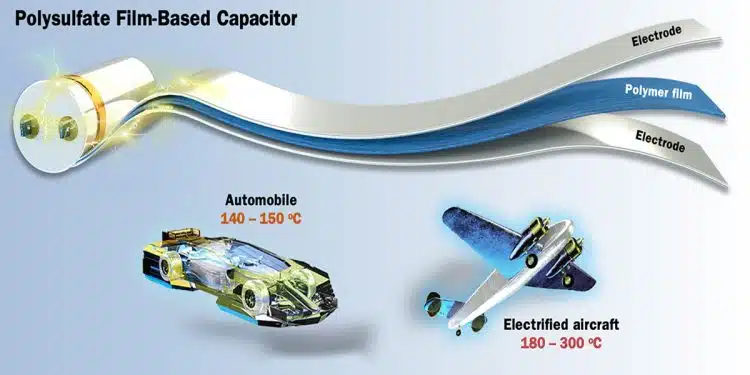Researchers at the Department of Energy’s Lawrence Berkeley National Laboratory (Berkeley Lab) and Scripps Research have now developed a new polymer-based polysulfate dielectric material ready for film capacitors that efficiently handles record amounts of energy while withstanding extreme temperatures and electric fields.
As reported in article Polysulfates Could Boost Energy Density and Temperature Range of Film Capacitors, the scientists published study on January 18, 2023 in Joule magazine found that the new polysulfates can be used to make polymer film capacitors that store and discharge high density of electrical energy while tolerating heat and electric fields beyond the limits of existing polymer film capacitors.
The device is composed of materials synthesized via a next-generation version of the chemical reaction for which three scientists won the 2022 Nobel Prize in Chemistry.
Polymer film capacitors are electrical components that store and release energy within an electric field using a thin plastic layer as the insulating layer. They make up 50% of the global high voltage capacitor market and offer advantages including light weight, low cost, mechanical flexibility, and robust cyclability. But state-of-the-art polymer film capacitors decrease dramatically in performance with increasing temperature and voltages. Developing new materials with improved tolerance for heat and electric fields is paramount; and creating polymers with near-perfect chemistry offers a way to do so.
“Our work adds a new class of electrically robust polymers to the table. It opens many possibilities to the exploration of more robust, high performing materials,” said Yi Liu, a chemist at Berkeley Lab and senior author on the Joule study reporting the work. Liu is the Facility Director of Organic and Macromolecular Synthesis at the Molecular Foundry, a DOE Office of Science user facility at Berkeley Lab.
In addition to remaining stable when subjected to high temperatures, a capacitor needs to be a strong “dielectric” material, meaning that it remains a strong insulator when subjected to high voltages. However, few known materials systems exist that deliver both thermal stability and dielectric strength. This scarcity is due to a lack of reliable and convenient synthesis methods, as well as a lack of fundamental understanding of the relationship between polymer structure and properties. “Improving the thermal stability of existing films while retaining their electrical insulating strength is an ongoing materials challenge,” said Liu.
A long-term collaboration between researchers at the Molecular Foundry and Scripps Research Institute has now met that challenge. They used a simple and quick chemical reaction developed in 2014 that swaps out fluorine atoms in compounds that contain sulfur-fluoride bonds, to yield long polymer chains of sulfate molecules called polysulfates. This Sulfur-Fluoride Exchange (SuFEx) reaction is a next-generation version of the click chemistry reaction pioneered by K. Barry Sharpless, a chemist at Scripps Research and two-time Nobel laureate in Chemistry, along with Peng Wu, also a chemist at Scripps Research. The near-perfect yet easy-to-run reactions join separate molecular entities through strong chemical bonds that form between different reactive groups. Liu’s team had originally used a variety of thermal analysis tools to examine the basic thermal and mechanical properties of these new materials.
As part of a Berkeley Lab program to synthesize and identify novel materials that could be useful in energy storage, Liu and his colleagues now find that, surprisingly, the polysulfates have outstanding dielectric properties, especially at high electric fields and temperatures. “Several commercial and lab-generated polymers are known for their dielectric properties, but polysulfates had never been considered. The marriage between polysulfates and dielectrics is one of the novelties here,” said He Li, a postdoctoral researcher in the Molecular Foundry and in Berkeley Lab’s Materials Sciences Division, and lead author of the study.
Inspired by the excellent baseline dielectric properties offered by polysulfates, the researchers deposited extremely thin layers of aluminum oxide (Al2O3) onto thin films of the material to engineer capacitor devices with enhanced energy storage performance. They discovered that the fabricated capacitors exhibited excellent mechanical flexibility, withstood electric fields of more than 750 million volts per meter, and performed efficiently at temperatures up to 150 degrees Celsius. In comparison, today’s benchmark commercial polymer capacitors only function reliably at temperatures lower than 120 degrees Celsius. Above that temperature, they can only withstand electric fields smaller than 500 million volts per meter, and the energy efficiency severely drops by over half.
The work opens new possibilities for exploring robust, high performing materials for energy storage. “We have provided deep insight into the underlying mechanisms that contribute to the material’s excellent performance,” said Wu.
The polymer strikes a balance of electrical, thermal, and mechanical properties, likely due to the sulfate linkages introduced by the click chemistry reaction. Because modular chemistry accommodates extraordinary structural diversity and scalability, the same route could offer a viable path to new polymers with higher performance that meet even more demanding operational conditions.
The polysulfates are strong contenders to become new state-of-the-art polymer dielectrics. Once researchers overcome barriers in large-scale manufacturing processes for thin film materials, the devices could greatly improve the energy efficiency of integrated power systems in electric vehicles and enhance their operational reliability.
“Who could have imagined that a wispy sulfate polymer film could fend off lightning and fire, two of the most destructive forces in the universe?!” said Sharpless.
“We’re continuously pushing the envelope of thermal and electrical properties, and accelerating the lab-to-market transition,” Liu added.
The technology is now available for licensing by contacting [email protected].
The work received funding from the Department of Energy’s Office of Science, the National Science Foundation, and the National Institute of Health. The work was carried out at the Molecular Foundry.































